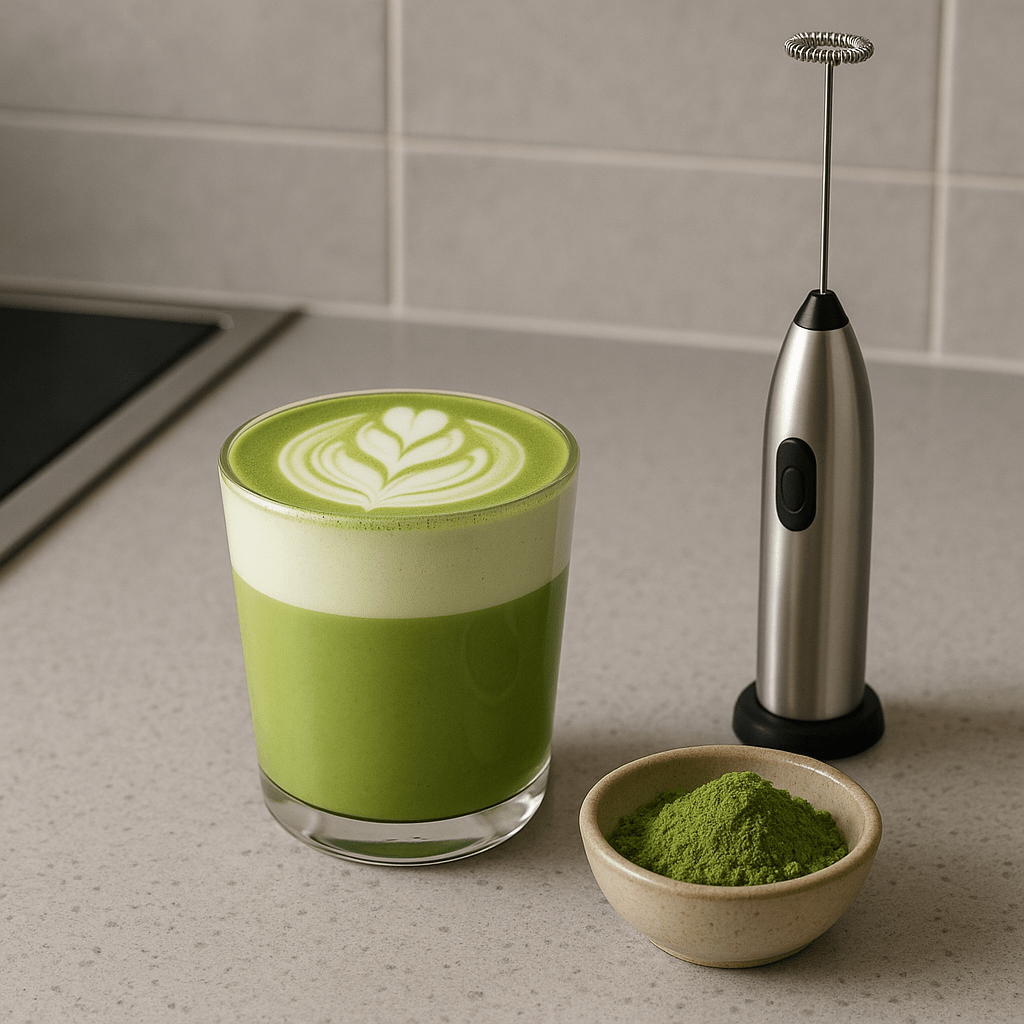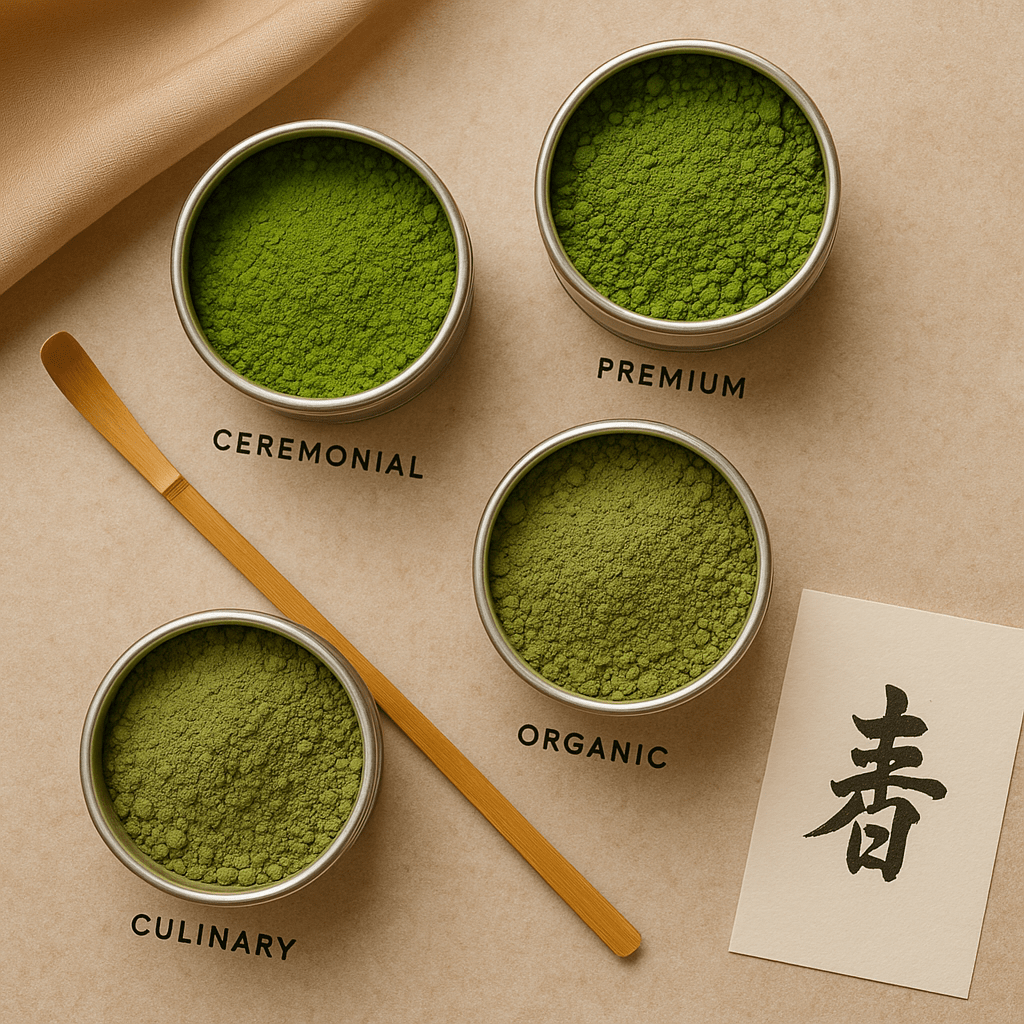All About Matcha: Types, Health Benefits, Preparation, and the Best Powder
Matcha is a finely ground Japanese green tea powder that has deservedly taken the wellness and culinary worlds by storm in recent years.
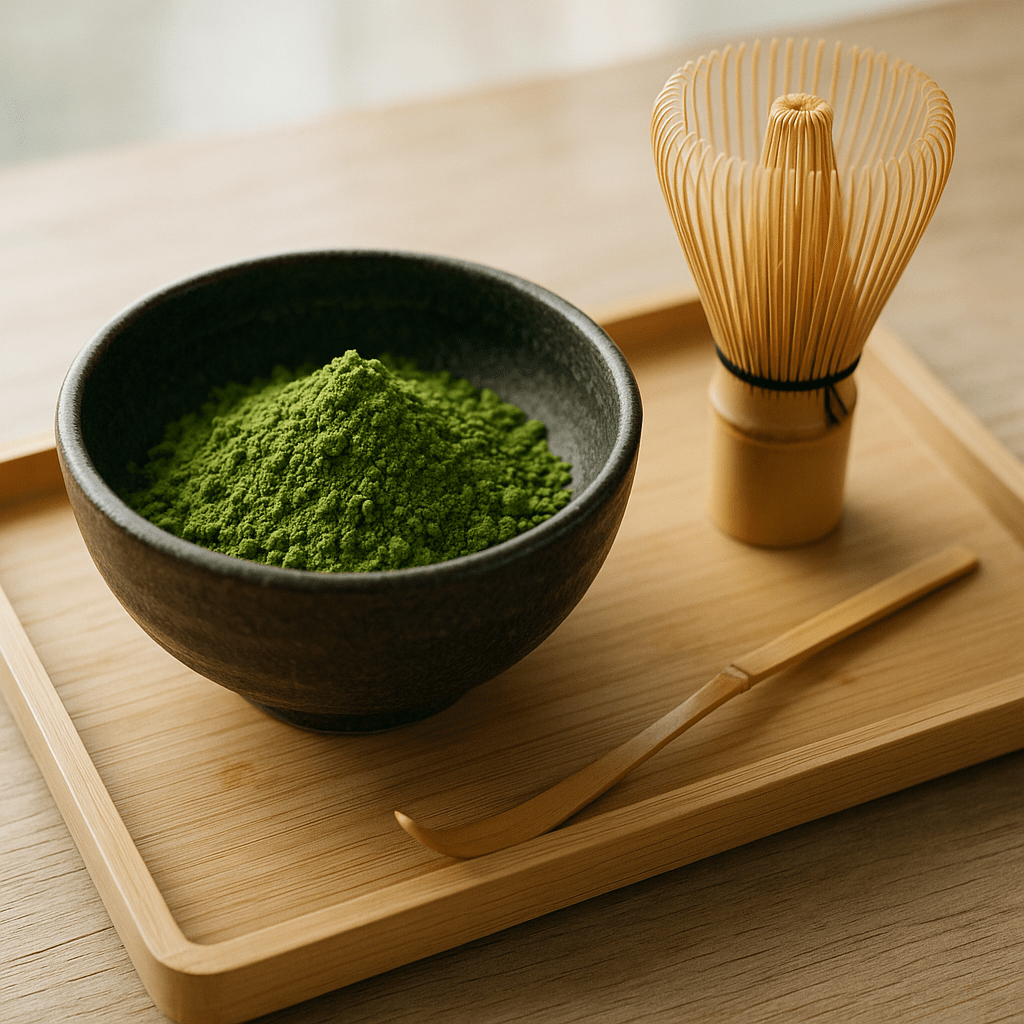
Unlike regular tea, which we steep and strain, when we consume matcha, we consume the entire tea leaf, receiving a concentrated dose of antioxidants, vitamins and minerals. Its history dates back to the 12th century in Japan, where it was used in traditional tea ceremonies. Today, matcha is valued not only for its delicate, rich taste, but also for its many beneficial properties.
In this comprehensive guide, you will learn everything about matcha – from its origins and types to preparation methods and choosing the best powder. You will understand the difference between ceremonial and culinary matcha, how to properly prepare it at home and how to choose the highest quality product.
What is matcha?
Matcha is finely ground green tea leaves that have been grown and processed in a special way. It’s not just green tea – it’s a whole Japanese tradition that has become a popular drink all over the world.
Matcha production begins a few weeks before harvest, when tea trees (Camellia sinensis) are covered with special structures to protect them from direct sunlight. This process is called “shading” (shading) and stimulates the production of chlorophyll in the leaves, giving them a bright, rich green color and increasing the amount of L-theanine, an amino acid that induces a state of relaxation.
After harvesting, the leaves are steamed, dried and carefully separated from the stems and veins. This intermediate product is called “tencha”. The tencha is then ground between granite stones until it turns into an extremely fine powder – real matcha. Traditionally, this grinding process was slow and painstaking, taking up to an hour for 30g of matcha.
The highest quality matcha is usually produced in the Uji, Nishio, Shizuoka and Kagoshima regions of Japan.
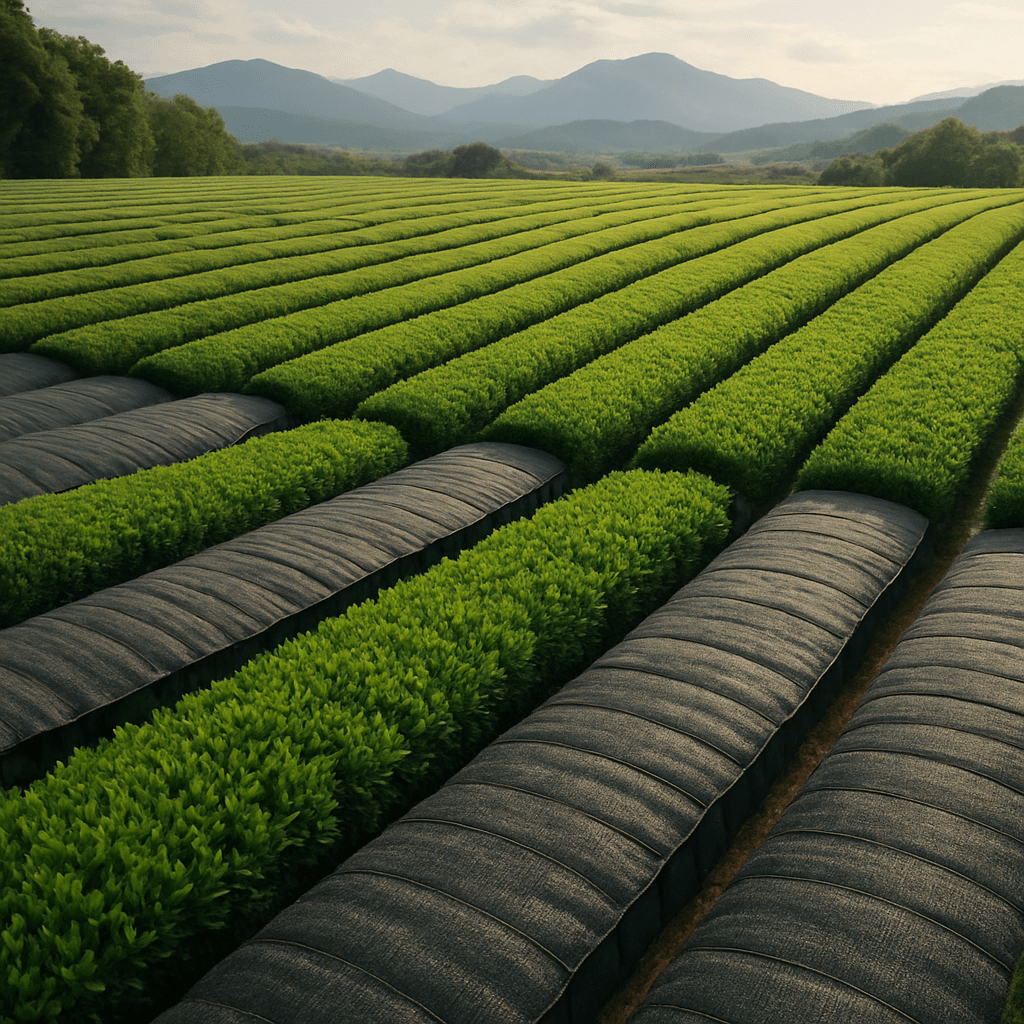
Uji matcha, produced in the Kyoto area, is particularly prized for its rich flavor and deep history.
How is matcha different from regular green tea?
The main differences between matcha and regular green tea are the methods of cultivation, processing, and consumption:
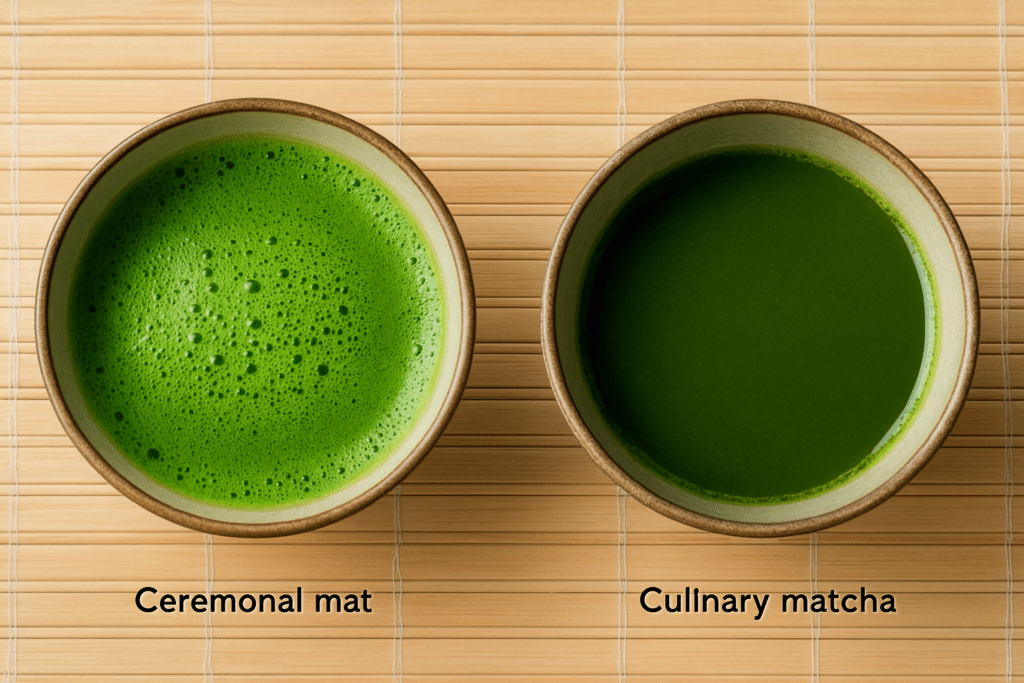
- Cultivation: Matcha is grown in the shade for the last 3-4 weeks before harvest, while regular green tea is grown in the sun.
- Usage: When consuming matcha, we consume the entire tea leaf, as the powder is suspended in water, while regular green tea is simply steeped and drunk.
- Nutritional value: Matcha contains significantly higher levels of antioxidants, vitamins and minerals, as the entire leaf is consumed.
- Taste: Matcha has a rich, earthy, sometimes even sweet taste with hints of seaweed, while regular green tea has a lighter, milder taste.
- Energy: Due to its unique combination of L-theanine and caffeine, matcha provides long-lasting energy, but without the characteristic “shock” that other sources of caffeine often cause.
Matcha Types and Grades: Ceremonial and Culinary
There are various quality grades in the world of matcha, but the simplest division is into ceremonial and culinary matcha. This division helps consumers understand for what purpose a particular matcha is best suited.
It is important to note that there is no official grading system for matcha in Japan, and the term “ceremonial” originally appeared in the Western market. However, the division has become a useful guide for buyers.
Ceremonial matcha is the highest quality matcha, made from the youngest, most delicately flavored leaves, usually from the first harvest. This is a grade intended for pure consumption in traditional tea ceremonies. It has a mild, delicate flavor, sweet hints, and is free of bitterness. Ceremonial matcha is a bright, rich green in color. It is the most expensive because it is made from the highest quality raw materials.
Culinary matcha is a lower quality matcha, often made from later harvest leaves. It is suitable for cooking, baking, lattes, and other beverages. Culinary matcha often has a more pronounced bitterness, a stronger flavor, and a less intense green color. It is less expensive and is perfect for experimenting in the kitchen.
In the Western market, we can sometimes find intermediate classifications such as “premium”, “cafe-grade”, or “latte-grade” matcha. These terms do not always reflect the Japanese understanding of quality, but they help consumers navigate the price-quality scale.
How to choose the right grade for your needs?
When choosing matcha, it is important to consider how you intend to consume it:
For traditional drinking: Choose ceremonial matcha if you want to enjoy the pure taste of matcha, drinking it traditionally prepared with water. This is the best way to experience the subtle and high-quality profile of matcha.
For lattes and milk-based drinks: You can choose a higher-quality culinary matcha or an intermediate-grade “latte-grade” matcha. Milk and other additives will mask the subtle nuances of flavors, so the most expensive matcha is not necessary here.
For baking and dishes: Culinary matcha is great for baking, ice cream, puddings and other dishes. Its stronger flavor remains even after heat treatment.
For beginners: If you are just starting to get acquainted with matcha, you can choose a higher-quality culinary matcha. It will cost less than ceremonial, but will still allow you to experience the true flavor profile of matcha.
Remember that price often reflects quality – high-quality matcha is rarely cheap, but that doesn’t mean the most expensive matcha will always be the best for you.
Health Benefits of Matcha
Matcha is known for its many beneficial properties, which have made it popular among health enthusiasts.
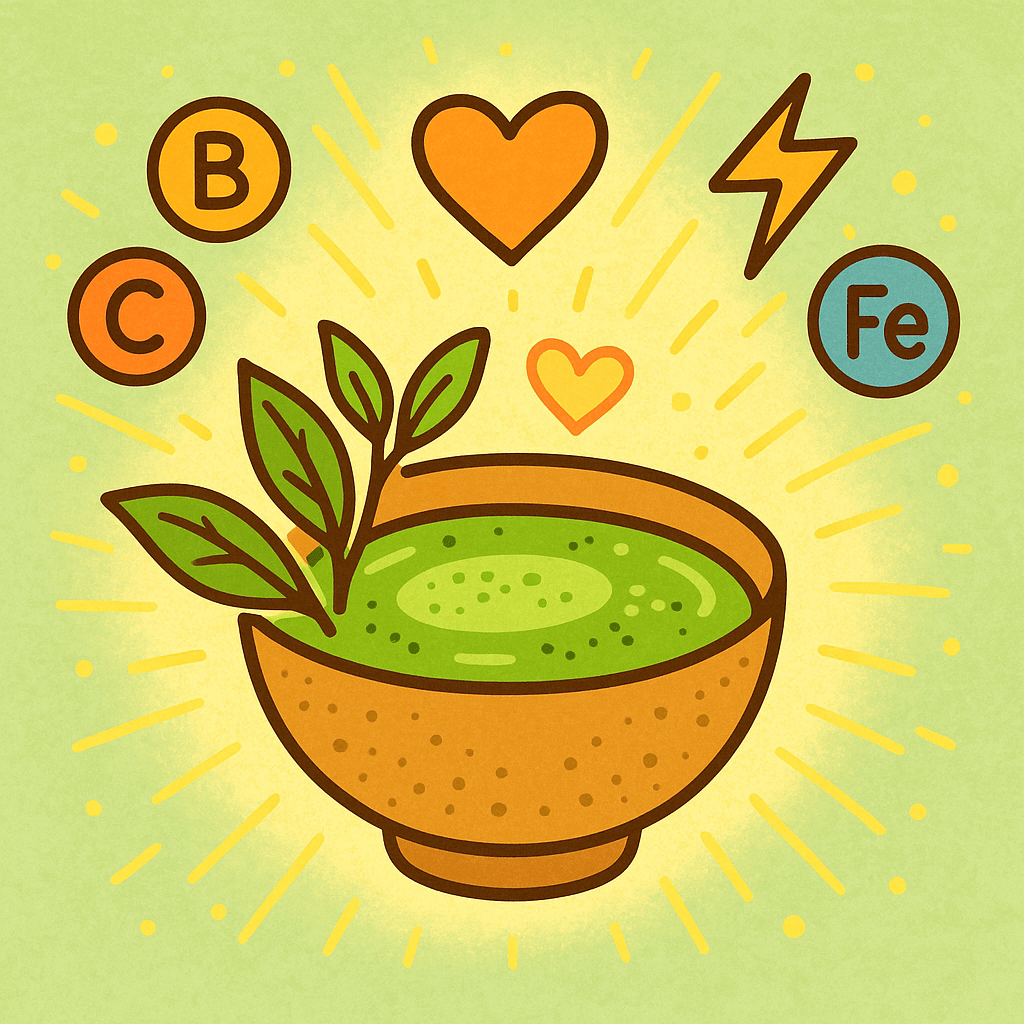
Because we consume the entire leaf, we get a full spectrum of nutrients.
One of the most unique benefits of matcha is its unusually high content of antioxidants, especially catechins. The main catechin in matcha is epigallocatechin gallate (EGCG), which has been linked to a variety of health benefits. Studies show that matcha can contain up to 3 times more antioxidants than high-quality green tea.
Matcha also stands out for its unique combination of L-theanine and caffeine. L-theanine is an amino acid that stimulates alpha wave activity in the brain, creating a state of relaxation without causing drowsiness. Combined with caffeine, which provides energy, this combination creates a unique “awake relaxation” – a surge of energy without the jitters or energy spikes that are typical of coffee
Other potential benefits of matcha include:
- May help support metabolism and weight control
- May contribute to heart health by lowering “bad” cholesterol
- May help regulate blood sugar levels
- Has anti-inflammatory properties
- May contribute to skin health due to its high antioxidant content
In terms of caffeine content, a 2g serving of matcha contains around 60-70mg of caffeine, compared to around 95mg in a cup of coffee. However, due to the effects of L-theanine, the caffeine is absorbed more slowly, providing a steady energy boost for 3-6 hours, without sudden energy spikes or crashes.
While matcha has many potential benefits, it’s important to remember that it’s not a miracle cure. Matcha is most beneficial as part of an overall healthy lifestyle, including a balanced diet and regular physical activity.
How to Prepare Matcha: Traditional and Modern Methods
Making matcha can be a real ceremony or a quick, enjoyable source of energy, depending on your needs. Let’s get acquainted with the traditional and modern methods of preparing matcha.
The traditional Japanese preparation of matcha, called “usucha” (thin tea), is probably the purest way to experience the subtleties of matcha’s flavor:

- Heat a chawan (tea bowl) with hot water, then pour it out.
- Sift 2g (about 1/2-1 teaspoon) of matcha powder into the bowl to remove any lumps.
- Add about 60-80ml of water at 70-80°C (not boiling!).
- Using a chasen (bamboo whisk), whisk the matcha in a “W” or “M” shape until a soft, creamy foam forms on the surface.
- Enjoy immediately after preparation.
Modern matcha latte preparation:
- Sift 1-2 g of matcha into a cup.
- Add 30-60 ml of hot water (70-80°C) and mix well until there are no lumps.
Separately, heat and froth 150-200 ml of milk (vegetable milk substitutes can be used). - Pour the frothed milk into the matcha mixture.
- If desired, sweeten with honey or another natural sweetener.
Preparing cold matcha:
- Mix 1-2 g of matcha with a small amount of warm water to form a lump-free paste.
- Add 200-250 ml of cold water or milk.
- Shake vigorously with a hand mixer or pour into a sealable container and shake well.
- Serve with ice
Essential tools for preparing matcha
Traditional preparation of matcha involves special tools that have deep cultural meaning:
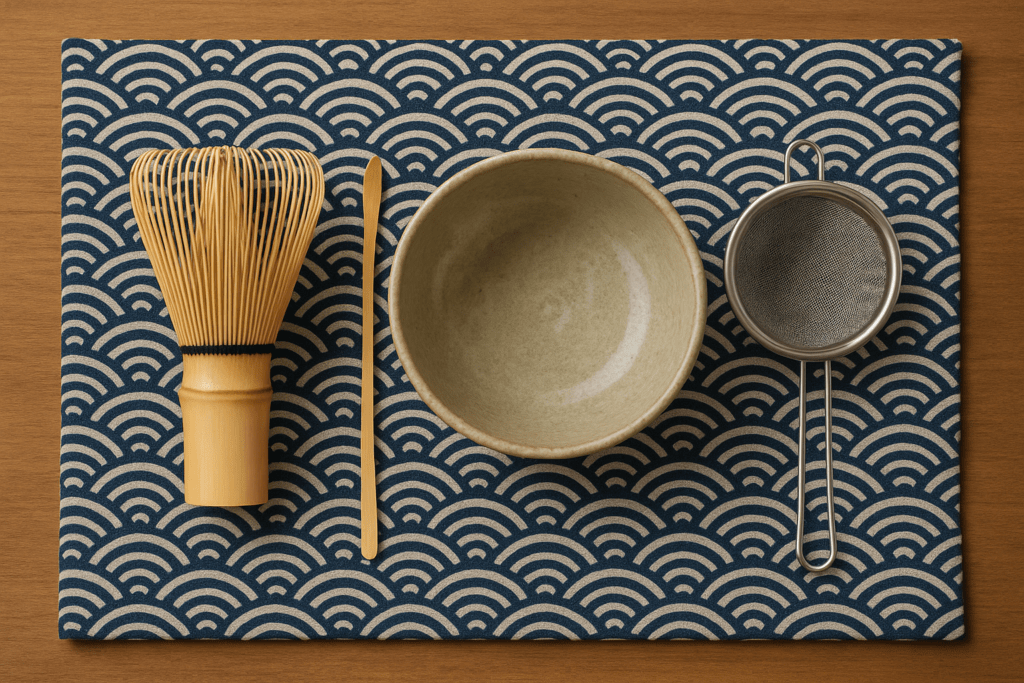
- Chasen (bamboo whisk): A specially hand-made bamboo whisk with 80-120 tines for stirring matcha.
- Chawan (tea bowl): A traditional ceramic bowl for drinking matcha, often handmade.
- Chashaku (bamboo scoop): A special scoop for scooping matcha powder (about 1 g of matcha).
- Furui (strainers): A fine sieve for removing lumps.
Modern alternative tools:
Electric or manual milk frother: for lattes and quick preparation.
Teapot with a horizontal spout: for precise control of water temperature.
Measuring spoon: for precise matcha dosage.
Thermos: for travel and matcha on the go.
Tips for perfect matcha every time
- Always sift your matcha powder to avoid lumps.
- Watch the water temperature: water that is too hot (over 80°C) will ruin the matcha, giving it a bitter taste.
- Use the right amount of water: for traditional matcha, the ratio is about 1:30 (powder:water).
- Whisk it right: quick “W” or “M” movements create a better foam than simple circular stirring.
- Experiment with plant-based milk substitutes: coconut, almond, oat milk give different flavors to your latte.
- Drink it right away: matcha is not meant to be kept for a long time, as the powder settles and the flavor changes.
- Decorate: you can use cinnamon, cocoa or vanilla for extra flavor in your latte.
Matcha Powder Buying Guide: What to Look For
When choosing matcha, it is important to pay attention to a few key aspects that will help you purchase a quality product
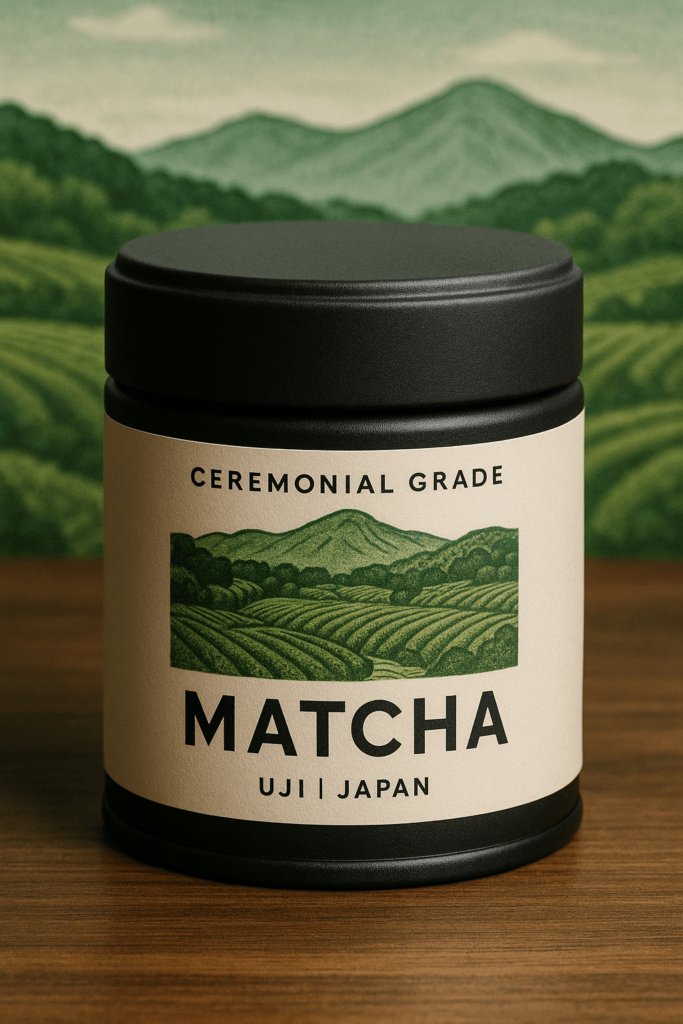
Choosing a quality matcha can make a huge difference in your experience.
First, pay attention to the place of origin of the matcha. Japan, especially the Uji, Nishio, Kagoshima, and Shizuoka regions, is known for its high-quality matcha. A country of origin statement on the label often indicates the transparency of the producer. The Uji area near Kyoto is particularly prized—it’s like the champagne region of the matcha world.
Color is one of the most important indicators of quality. High-quality matcha should be bright green, with a subtle greenish-yellow hue. Pale, yellowish, or brownish-green often indicates oxidation or lower-quality leaves. It’s a good sign if the manufacturer shows actual photos of their product, not just generic illustrations of matcha.
Freshness is critical for matcha. Look for manufacturers that list a harvest date or “best by” date. Good-quality matcha is best consumed within 3-6 months of opening the package and within a year of harvest. Pay attention to the tightness of the packaging – it is best if the matcha is vacuum-packed, in a light-tight package.
Price is also an important indicator. High-quality ceremonial matcha will not be cheap – the price of 30 g of quality ceremonial matcha usually starts at 25-30 euros. If a product is advertised as “ceremonial matcha” for a very low price, this may be a sign that it is actually a lower-quality product.
Organic certifications are not a necessary sign of quality matcha, but they can give you additional confidence. Look for JAS (Japanese Agricultural Standard), USDA Organic or EU organic production certificates.
If possible, look for “single-origin” matcha. This means that the tea is harvested from one specific region or even farm, rather than blended from different sources. Such matcha often has a more consistent, distinctive flavor.
.
Tips for keeping matcha fresh
Matcha is very sensitive to air, light, heat and humidity. Here are some tips for keeping matcha fresh:
- Store in the refrigerator: cool temperatures slow down the oxidation process.
- Use an airtight container: vacuum-sealed or with a special valve that releases air.
- Protect from light: dark-colored or opaque containers will protect against UV rays.
- Buy in smaller quantities: it is better to buy smaller quantities more often than a large amount at once.
When transferring from the original packaging, keep the expiration date information.
Keep away from strong odors: matcha can absorb environmental odors.
Properly stored, matcha remains of high quality for about 6-8 weeks after opening. Sealed, vacuum-sealed packaging – up to a year from the date of manufacture. In my search for the best matcha powder, I tested various products, evaluating their taste, color, texture and overall properties in different categories.
Here are the detailed results to help you choose the best matcha for your needs.
Best Overall Matcha Powder Quality
Ippodo Tea Ummon-no-mukashi – This ceremonial matcha from the Uji region has a wonderfully rich, bright green color and a perfectly balanced, smooth flavor with sweet hints. It has no bitterness, and the foam texture is creamy and long-lasting. Although the price is higher (around 40 EUR for 40 g), the quality justifies the investment for true matcha enthusiasts. It is perfect for traditional preparation and is the perfect choice for special occasions.
Best matcha for lattes
Matchaeologist Matsu – This premium matcha is ideally balanced for lattes. Matsu has a rich, nutty flavor that goes well with milk, but does not lose its character. Its color remains bright even when mixed with milk, and the flavor is strong enough to penetrate the creaminess of the milk. Its subtle bitterness gives depth to a latte. A small 20 g package costs around 22 EUR – a good compromise between price and quality.
Best Value Matcha
Mizuba Tea Nagomi – This “everyday” option offers surprising quality at an attractive price. Nagomi has a bright green color and a balanced flavor with subtle grassy and nutty notes. While it doesn’t have the complexity of more expensive alternatives, it’s a great choice for everyday consumption. The price – around 20 EUR for 40 g – makes it affordable for those who want to drink quality matcha every day.
Best matcha for baking
Aiya Culinary Matcha – This matcha specially created for culinary purposes has a strong, expressive flavor that persists even after heat treatment. It has a more pronounced bitterness compared to ceremonial matcha, but this is an advantage in baking, especially when combined with sweeteners. The price – around 15 EUR for 100 g – makes it an economical choice for experiments in the kitchen. Perfect for cakes, cookies, ice cream and other desserts.
Other matcha powders worth considering
- Encha Organic Ceremonial Grade – organic matcha from the Uji region, with a mild, sweet taste and light green color. Certified USDA Organic. Mid-to-high-end price.
- Kenko T ea Ceremonial Matcha– an Australian company offering high-quality matcha from the Nishio region. It is characterized by a rich taste and creamy foam.
- DoMatcha Summer Harvest – a mid-range matcha, suitable for both drinking and culinary purposes. A good choice for beginners who want to get acquainted with the world of matcha.
- Jade Leaf Daily Matcha – organic, affordable matcha for everyday consumption. The manufacturer offers various package size options, so you can start with a small amount.
Regardless of your choice, the most important thing is to store matcha in the right conditions and consume it as soon as possible after opening to maintain its special properties and taste.
Matcha is more than just a tea, it is an experience that can enrich your day, open up new culinary possibilities and contribute to your overall well-being. By starting with a quality product and learning how to prepare it properly, you will discover the entire Japanese tradition that has become a modern symbol of well-being. Whether you drink it traditionally, enjoy it as a latte, or incorporate it into your culinary masterpieces, matcha will undoubtedly become a discovery in your drinks and cuisine.
Frequently Asked Questions (FAQ)
What is the difference between ceremonial and culinary matcha?
Ceremonial matcha is made from the youngest, top leaves and is best for drinking; culinary matcha is made from older leaves and is suitable for cooking or baking, and can sometimes be more bitter and less nuanced in flavor.
Does matcha have more caffeine than coffee?
Matcha has less caffeine than most coffees (typically 40-70 mg per teaspoon compared to 95 mg in a cup of coffee), but it provides a calming, long-lasting energy boost thanks to L-theanine.
How should I store matcha to keep it fresh?
Store matcha in an airtight, light-tight container in the refrigerator. Consume within 2-3 months of opening to maintain the best color and flavor.
Can I use the same matcha for both drinking and baking?
Yes, but ceremonial grade matcha is best for drinking, while culinary grade is best for baking. For versatility, choose an affordable drinking matcha.
Why is the color of matcha powder important?
A bright, rich green color indicates freshness and higher quality; yellowish or cloudy colors often indicate oxidation or lower quality leaves.

